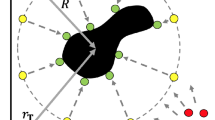Abstract
In the swarm robotics community, Lévy walk has been recognized as one of the most efficient search strategies for the environment, with sparse targets that robots have no prior knowledge of. Generally, Lévy walk is generated by following the Lévy distribution. Our previous results also confirmed that the Lévy walk outperformed the usual random walk for exploration strategy in real swarm robot experiments. On the other hand, it has been reported in several papers that each individual in swarm robots does not follow Lévy distribution due to collision avoidance from other robots, resulting in inefficient search. Therefore, we introduced concessions to the swarm robots to improve search efficiency. This paper investigated the performance of the Lévy walk with concession. Robots concede other robots when they receive the signal that other robots execute longer walks. We conducted a series of computer simulations varying ranges detecting other robots’ walk distance signals, the number of robots, the number of targets, and the distribution of targets. The results suggest that the search efficiency of Lévy walk was improved by concession. Furthermore, we confirmed that improving search efficiency saturates beyond the threshold of range detecting other robots’ walk distance signals.











Similar content being viewed by others
Notes
Şahin [3] claimed to use these criteria as a measure of the degree of SR in a particular study.
References
Trianni V (2008) Evolutionary swarm robotics. Springer-Verlag
Brambilla M, Ferrante E, Birattari M, Dorigo M (2013) Swarm robotics: a review from the swarm engineering perspective. Swarm Intell 7(1):1–41
Şahin E (2005) Swarm robotics: from sources of inspiration to domains of application. Lect Notes Comput Sci 3342:10–20
Li J, Andrew LLH, Foh CH, Zukerman M, Hsiao-Hwa C (2009) Connectivity, coverage and placement in wireless sensor networks. Sensors 9(10):7664–7693
Katada Y (2014) “Connectivity of swarm robot networks for communication range and the number of robots based on percolation theory,” Proc. of the 2014 IEEE/SICE International Symposium on System Integration, pp.93–98,
Katada Y, Nishiguchi A, Moriwaki K, Watakabe R (2016) Swarm robotic network using Lévy flight in target detection problem. Artif Life Robot 21(3):295–301
Lévy P (1937) Theorie de l’addition des veriables aleatoires. Gauthier-Villars
Koyama H, Namatame A (2008) Comparison of efficiency of random walk based search and Levy flight search. Inform Process Soc Jpn Tech Rep 20:19–24 (In Japanese)
Khaluf Y, Havermaet SV, Simoens P (2018) “Collective Lévy walk for efficient exploration in unknown environments,” Artificial Intelligence: Methodology, Systems, and Applications, Lecture Notes in Computer Science, Vol.11089, Springer
Nauta J, Havermaet SV, Simoens P, Khaluf Y (2020) “Enhanced foraging in robot swarms using collective Lévy walks,” Proc. of the 24th European Conference on Artificial Intelligence-ECAI
Katada Y, Ohkura K (2023) “Swarm Robots Using Lévy Walk in Targets Exploration -Computer Simulation for Performance of LevyWalk with Concession,” Proceedings of the 6th International Symposium on Swarm Behavior and Bio-Inspired Robotics (SWARM2023), pp.1523–1528
Lee CY, Yao X (2004) Evolutionary programming using mutations based on the Lévy probability distribution. IEEE Trans Evol Comput 8:1–13
Katada Y (2018) Swarm robotic network using Lévy flight for exploration -computer simulation for sweeping. Trans Soc Instrument Control Eng 54(1):22–30 (In Japanese)
Open Dynamics Engine (ODE), http://ode.org/
Brooks RA (1986) A robust layered control system for a mobile robot. IEEE J Robot Autom 2(1):14–23
Author information
Authors and Affiliations
Corresponding author
Additional information
Publisher's Note
Springer Nature remains neutral with regard to jurisdictional claims in published maps and institutional affiliations.
About this article
Cite this article
Katada, Y., Ohkura, K. Swarm robots using Lévy walk with concession in targets exploration. Artif Life Robotics 28, 652–660 (2023). https://doi.org/10.1007/s10015-023-00900-z
Received:
Accepted:
Published:
Issue Date:
DOI: https://doi.org/10.1007/s10015-023-00900-z




